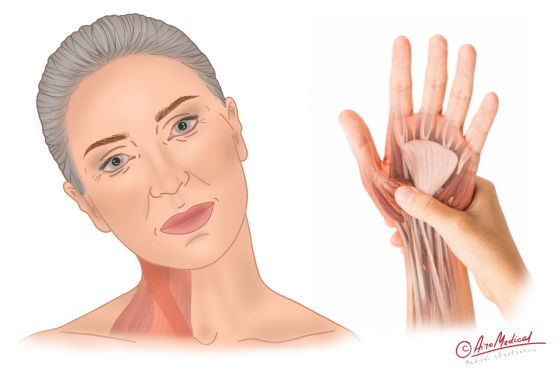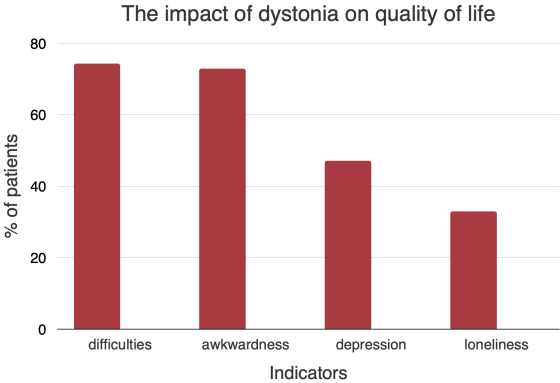Dystonia guide
 What is dystonia?
What is dystonia?
 Dystonia is a neurological movement disorder defined by involuntary muscle contractions (spasms). Involuntary muscle contractions include twisting, repetitive and patterned movements, and abnormal postures, making it difficult for people to control their actions. In addition, moves and poses can be painful.
Dystonia is a neurological movement disorder defined by involuntary muscle contractions (spasms). Involuntary muscle contractions include twisting, repetitive and patterned movements, and abnormal postures, making it difficult for people to control their actions. In addition, moves and poses can be painful.
Dystonia is not a single illness but a syndrome - a set of symptoms that cannot be attributed to one cause since they have common elements. In addition, some forms may affect specific areas of the body, such as the neck, face, jaw, eyes, limbs, or vocal cords.
Dystonia is the third most common movement disorder after tremors and Parkinson's disease. The exact cause of dystonia is unknown but may involve changes in multiple brain areas or the connections between them.
 Diagnostic tests
Diagnostic tests
Symptoms of dystonia can vary from very mild to severe. Dystonia can affect different body parts, and often the signs progress in stages. Some early symptoms include:
- "dragging foot";
- foot spasms;
- involuntary stretching of the neck;
- uncontrolled blinking;
- speech difficulties.
Currently, there are no tests to confirm the diagnosis of dystonia. Instead, the diagnosis is based on the physician's ability to observe symptoms and to take and analyze a patient history. In addition, the doctor may prescribe medical tests to rule out other conditions or disorders.
- Blood and urine tests - can help determine the patient's general health and rule out other neurological conditions.
- Spinal tap or lumbar puncture - the doctor takes a sample of the cerebrospinal fluid surrounding the brain and spinal cord. This test can help exclude other diseases.
- Brain MRI scan - is a painless, non-invasive examination that provides detailed images of the brain and its stem. The test helps rule out such conditions as a stroke, a brain tumour, or unusual brain structures.
- Electromyography (EMG) or electroencephalography (EEG) measures the amount of electrical activity in the muscles.
- Genetic testing - studies the DNA sequence or structure of a person's chromosomes to detect the corresponding changes.
Dystonia is classified according to the parts of the body affected. It is focal dystonia if only one body part is affected, such as the eyes, neck, limb, or voice. In case a larger area is involved, such as the neck and arms, it is segmental dystonia. If the cramps affect the arm and leg on the same side, it is called hemidistonia. It is multifocal dystonia if two or more unrelated body parts are concerned. Finally, if the disease is more common, it is generalized dystonia.
 Treatment methods
Treatment methods
There is no complete cure for dystonia, so treatment is aimed at relieving symptoms. Nowadays, traditional drug treatment is used: injection and oral drugs.
- Botulinum neurotoxin (BNT) injections are a standard treatment for several types of dystonia. This therapy treats symptoms in a specific muscle group, such as the neck or limbs.
- Anticholinergics - include Artane® (trihexyphenidyl), Cogentin® (benztropine), and Parsitan® (etopropazine). These drugs block a chemical neurotransmitter called acetylcholine, which plays an important role in muscle activation.
- Benzodiazepines - include Valium® (diazepam), Klonopin (clonazepam), and Ativan® (lorazepam). These drugs act on the GABA-A chemical transmitter.
- Baclofen (Lioresal®) - stimulates the body's ability to process a GABA-B transmitter. Baclofen can be taken orally, or the drug can be continuously delivered to the nervous system using a surgically implanted device called a baclofen pump.
- Some patients with certain types of dystonia respond to drugs that increase dopamine levels. These drugs include Sinemet (levodopa) or Parlodel (bromocriptine).
- Tetrabenazine (Xenazine®) - is a drug that lowers dopamine levels and is used to treat a variety of movement disorders.
- Additional drugs are sometimes used for certain forms of dystonia: muscle relaxants, anticonvulsants, and (rarely) dopamine-lowering agents, among many others.
Along with drug treatments, specialists may recommend non-drug approaches. It includes physical and occupational therapy and speech or voice therapy. In addition, rehabilitation help achieve greater awareness and control over the body. The following rehabilitation methods are very effective:
- Physiotherapy - procedures and exercises that help increase muscle strength, reduce muscle stiffness and spasms, reduce the risk of falls, etc.
- Occupational therapy - hand therapy using an exercise program and functional activities alone or in groups.
- Speech and language therapy - is the education of family members and assistance in written communication.
- Relaxation and stress management include meditation, relaxation training, tai chi, yoga, etc. Some patients find these methods helpful.
 New treatment options
New treatment options
Dystonic symptoms can seriously impair patients' quality of life, while the response of dystonia to oral medication can be disappointing. In this case, doctors may recommend surgery. In the treatment of dystonia, the following surgical operations are used:
- Deep brain stimulation (DBS) - is a surgical procedure used to treat various neurological disorders. A battery-powered stimulator—essentially a brain pacemaker—is implanted in the body and provides electrical stimulation to areas of the brain responsible for causing symptoms of dystonia. The stimulator is implanted in the chest, and extension wires connect the stimulator to wires (electrodes) deep in the brain. The stimulation process is controlled remotely.
- Selective denervation - this surgery will be performed for people who cannot manage their symptoms with any other treatment. This procedure cuts the nerves that control muscle spasms.
- Other operations are aimed at interrupting the pathways responsible for abnormal movements at various levels of the nervous system. Some interventions intentionally damage small areas of the thalamus (thalamotomy), the globus pallidus (pallidotomy), or other deep brain centres. Patients report a substantial reduction in symptoms after surgery.
New approaches to treating dystonia include gene therapy and transcranial magnetic stimulation. Gene therapy may be promising for patients with hereditary dystonia, which is thought to be involved in a specific gene. However, gene therapy for dystonia has not yet been tested in patients. Transcranial magnetic stimulation is also being inspected as a non-invasive stimulation for the treatment of dystonia. So far, it has only been studied in small controlled trials of focal dystonia of the hands or cervix. Research is ongoing.
 Statistics and prognosis
Statistics and prognosis
Dystonia is dangerous for the lonely and depressive state of the patient. External symptoms can be a source of great embarrassment and frustration. The fact that there is no known cure exacerbates this issue. In addition, dystonia often leads to disability. The aim of the study, carried out by the Swedish Dystonic Patients' Association, was to identify factors in dystonia that affect the self-reported quality of life and health.
The greater the severity of dystonia, the worse life quality. Greater severity is associated with more significant disability. The pain was present in 84% of patients, causing disability in 41%. The most frequent complaints were: difficulties in fulfilling professional and personal requirements (74.3%), an embarrassment in public places (72.9%), depression, irritation and anger (47.1%), loneliness and isolation. (32.9%).

Living with this disease is extremely difficult. AiroMedical specialists treat many patients and are very well versed in the many manifestations of dystonia and the best diagnostic instruments to assess the problem. AiroMedical professionals will offer a wide treatment range for all forms of dystonia, including botulinum therapy, physical, occupational and speech therapy, and deep brain stimulation.
References:
- Brain Foundation: DYSTONIA
- American Association of Neurological Surgeons: Dystonia
- National Library of Medicine: Treatment strategies for dystonia
- NHS: Dystonia
- Frontiers Media S.A.: Dystonia Management: What to Expect From the Future? The Perspectives of Patients and Clinicians Within DystoniaNet Europe
- Dystonia Medical Research Foundation: What is Dystonia? Dystonia is a Movement Disorder
- Healthline Media: Focal Dystonia
- WebMD: Dystonia: Causes, Types, Symptoms, and Treatments
- National Institutes of Health (NIH): Dystonias Fact Sheet